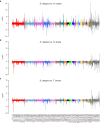A chromosome-level genome assembly of the Asian house martin implies potential genes associated with the feathered-foot trait
- PMID: 38607414
- PMCID: PMC11152083
- DOI: 10.1093/g3journal/jkae077
A chromosome-level genome assembly of the Asian house martin implies potential genes associated with the feathered-foot trait
Abstract
The presence of feathers is a vital characteristic among birds, yet most modern birds had no feather on their feet. The discoveries of feathers on the hind limbs of basal birds and dinosaurs have sparked an interest in the evolutionary origin and genetic mechanism of feathered feet. However, the majority of studies investigating the genes associated with this trait focused on domestic populations. Understanding the genetic mechanism underpinned feathered-foot development in wild birds is still in its infancy. Here, we assembled a chromosome-level genome of the Asian house martin (Delichon dasypus) using the long-read High Fidelity sequencing approach to initiate the search for genes associated with its feathered feet. We employed the whole-genome alignment of D. dasypus with other swallow species to identify high-SNP regions and chromosomal inversions in the D. dasypus genome. After filtering out variations unrelated to D. dasypus evolution, we found six genes related to feather development near the high-SNP regions. We also detected three feather development genes in chromosomal inversions between the Asian house martin and the barn swallow genomes. We discussed their association with the wingless/integrated (WNT), bone morphogenetic protein, and fibroblast growth factor pathways and their potential roles in feathered-foot development. Future studies are encouraged to utilize the D. dasypus genome to explore the evolutionary process of the feathered-foot trait in avian species. This endeavor will shed light on the evolutionary path of feathers in birds.
Keywords: Asian house martin; Hi-C; PacBio Hifi; chromosome-level genome assembly; feathered feet; ptilopody.
© The Author(s) 2024. Published by Oxford University Press on behalf of The Genetics Society of America.
Conflict of interest statement
Conflicts of interest The authors declare no conflict of interest.
Figures



Similar articles
-
Avian skin development and the evolutionary origin of feathers.J Exp Zool B Mol Dev Evol. 2003 Aug 15;298(1):57-72. doi: 10.1002/jez.b.26. J Exp Zool B Mol Dev Evol. 2003. PMID: 12949769 Review.
-
Parallel Genetic Origin of Foot Feathering in Birds.Mol Biol Evol. 2020 Sep 1;37(9):2465-2476. doi: 10.1093/molbev/msaa092. Mol Biol Evol. 2020. PMID: 32344429 Free PMC article.
-
Fossilized skin reveals coevolution with feathers and metabolism in feathered dinosaurs and early birds.Nat Commun. 2018 May 25;9(1):2072. doi: 10.1038/s41467-018-04443-x. Nat Commun. 2018. PMID: 29802246 Free PMC article.
-
Identification of genes involved in regulating the development of feathered feet in chicken embryo.Poult Sci. 2023 Sep;102(9):102837. doi: 10.1016/j.psj.2023.102837. Epub 2023 Jun 2. Poult Sci. 2023. PMID: 37390552 Free PMC article.
-
Time lapse: A glimpse into prehistoric genomics.Eur J Med Genet. 2020 Feb;63(2):103640. doi: 10.1016/j.ejmg.2019.03.004. Epub 2019 Mar 25. Eur J Med Genet. 2020. PMID: 30922926 Free PMC article. Review.
References
MeSH terms
Grants and funding
LinkOut - more resources
Full Text Sources
